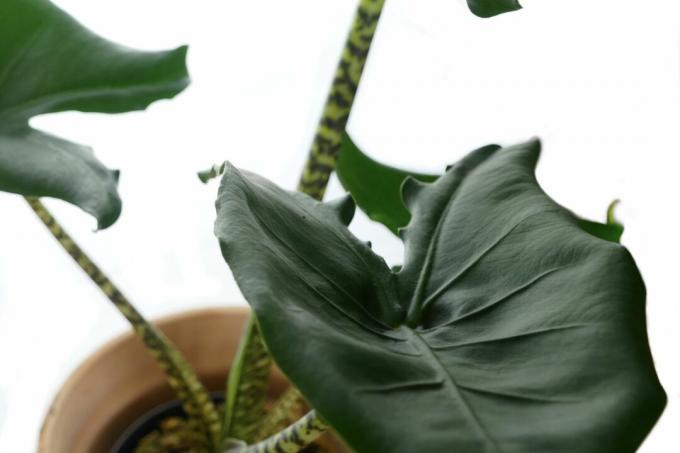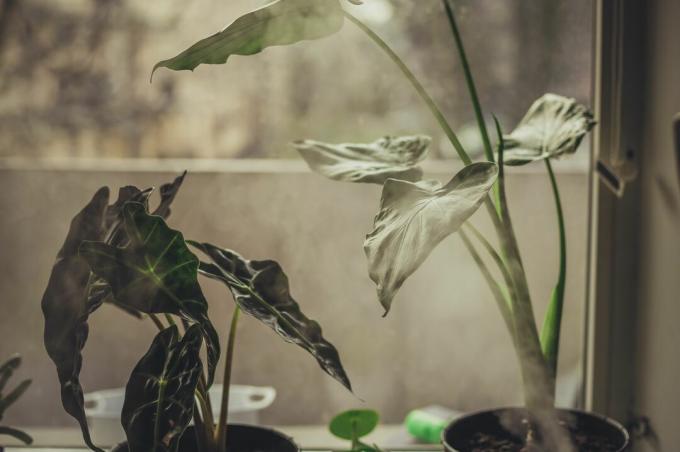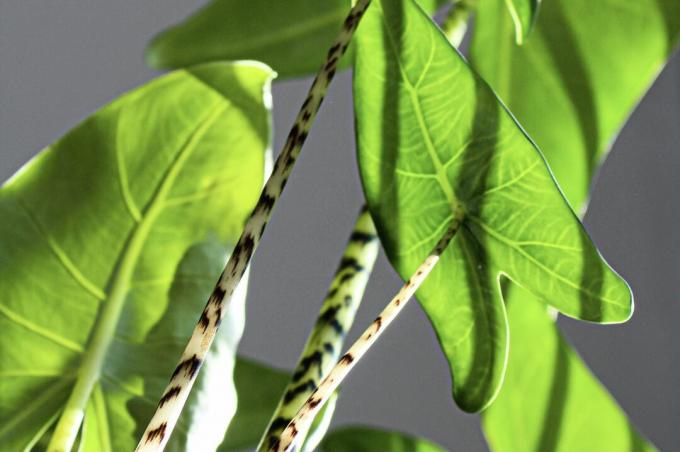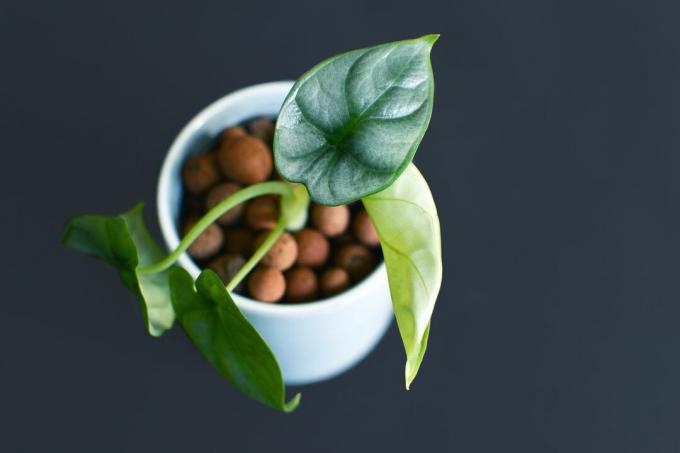In the Alocasia zebrina It is an unusual foliage plant with a striped look. We give you tips on varieties, care and propagation of the Alocasia zebrina.

the Alocasia zebrina is a real eye-catcher with its striped stem. In this article you can read how you can cultivate the plant, which is native to Southeast Asia, what site conditions it needs and how to care for it properly.
"Contents"
- Alocasia zebrina: origin, properties and flowering
- The most beautiful varieties of Alocasia zebrina
- You should pay attention to this when planting: location, soil and Co.
-
Alocasia zebrina: care of the houseplant
- Watering Alocasia zebrina
- Fertilize Alocasia zebrina
- Cut the houseplant
- Repotting Alocasia zebrina
- Yellow leaves on Alocasia zebrina
- Propagating Alocasia zebrina: offshoots, seeds or cuttings?
- Is the Alocasia zebrina poisonous?
Alocasia zebrina: origin, properties and flowering
One of the most decorative green plants for house and apartment is the
Alocasia zebrina. It is also known to us under trivial names such as Alocasia or Pfeilblatt. From a botanical point of view, the Alocasia zebrina to the genus of the arrow leaf plants (Alocasia) and thus to the aroid family (Araceae). It grows with basally branched leaves without a stem.Originally comes the Alocasia zebrina from the tropical and subtropical forests of Southeast Asia, especially those of the Philippines. The evergreen, herbaceous plant can grow up to 1.5 meters high and forms simple stalked leaves. The leaves are distinctly heart-shaped and grow at the end of a showy, mostly green and white striped petiole. They can grow between 10 and 35 cm long, which makes for lush foliage decoration. the Alocasia zebrina Only under the best conditions does it develop flowers typical of the arum family, which consist of an inflorescence stalk, a bract and a spadix. It forms both female and male flowers on a plant, with each individual flower being unisexual. the Alocasia zebrina is not self-fertile. However, if the flowers are fertilized by a second Alocasia, a berry can be formed as a fruit organ, via which the Alocasia zebrina can multiply.
The most beautiful varieties of Alocasia zebrina
The selection of the varieties of Alocasia zebrina is large and ranges from simple to eye-catching patterns. Here are some of the most popular Alocasia zebrina Sorts:
- Alocasia zebrina ‘Tiger Arrow Leaf’: Strikingly patterned stem with white and dark green stripes reminiscent of tiger fur; multi-colored, wavy leaves; grows up to 1 meter high; loose, airy growth.
- Alocasia zebrina ‘Variegata’: Red-patterned petiole; irregular, green-white variegated leaves; grows up to 1.5 meters high.
- Alocasia zebrina ‘Reticulata’: Discreet petiole; particularly pronounced heart shape of the leaves, striking leaf pattern in light and dark green; grows up to 90 centimeters high.

You should pay attention to this when planting: location, soil and Co.
For the Alocasia zebrina a partially shaded to sunny location is just right. Direct sunlight should be avoided for the most part, as too much exposure can lead to sunburn. Above all, the intense midday sun should be avoided. Five hours of sun per day are ideal for the plant to grow well. Tropical high humidity helps vigorous leaf development, but is not essential. who the Alocasia zebrina If you want to do something good, you can regularly spray it with some lime-free water, such as rainwater or mineral water. The ambient temperature must not fall below 5 °C, otherwise the plant will be damaged. Room temperatures of 20 to 25 °C are ideal during vegetation. In the winter quarters, on the other hand, it should not get colder than 18 °C for a long time. Good locations for hibernation are bright stairwells or less heated living rooms.
The substrate for the Alocasia zebrina should above all be permeable to avoid waterlogging. A nutrient-rich soil, such as ours Plantura organic universal soil, supplies the plant with all the important nutrients and thus offers good growth conditions. the Alocasia zebrina grows best in slightly acidic soil conditions. As such, she benefits from a layer of pine bark on top of the potting soil, or some acidic basalt or granite rock dust mixed into the soil.
Because the root growth of the Alocasia zebrina is less pronounced, a narrower pot of about 21 cm in diameter is sufficient at the beginning. Due to their rapid growth and high nutrient requirements, it is important to repot them regularly and, depending on the size of the plant, to enlarge the pot. Regular watering and regular fertilization with a liquid green plant fertilizer are important during growth. This creates all the conditions for healthy and vigorous leaf growth. Since the Alocasia is dependent on a permanent water supply, an irrigation aid such as Blumat drippers or a clay cone with a water reservoir can be used.
Alocasia zebrina: care of the houseplant
The care of Alocasia zebrina is less complicated. However, the large leaves of the plant tend to catch dust, so they should be wiped down with a damp cloth from time to time. the Alocasia zebrina also tolerates being showered from time to time without any problems, as long as the water is lukewarm. This cleans the leaves like a natural rain shower. the Alocasia zebrina drips occasionally, it secretes water over the leaf edges in the morning, which is called guttation. That's not too bad, you should only pay attention to a moisture-tolerant surface.

Watering Alocasia zebrina
Because of the large leaf surface, evaporation is the Alocasia zebrina very large. It therefore needs a lot of water. It's important to keep the substrate constantly moist, but not too wet. The root ball can dry out in the meantime, but should not dry out completely. The finger test helps to determine the right time for watering. the Alocasia zebrina prefers lime-poor water, because only slightly acidic soil allows it to absorb nutrients well. Collected rainwater or mineral water is best for watering. During the hibernation, the Alocasia zebrina be poured less.
Fertilize Alocasia zebrina
In order to provide the plant with the best possible nutrients during vegetation, it should be fertilized weekly. A green plant fertilizer that is administered with the irrigation water is suitable for this. In this way, the important nutrients can be distributed quickly in the soil solution and reach all parts of the plant. Our Plantura organic indoor and green plant fertilizer For example, it also contains microorganisms that promote active soil life and thus enable the plant to grow healthy and strong leaves.
Cut the houseplant
The leaves of Alocasia zebrina usually die during the hibernation before they sprout again the next year. They can then be cut off. Likewise, diseased leaves should always be removed to prevent the spread of disease. A topiary or the like is not necessary for the ornamental leaf plant. In addition, the plant constantly forms new leaves and sheds older ones. That's nothing to worry about: the brown, old leaves can simply be cut off. But you should leave a stub of about four centimeters.
Repotting Alocasia zebrina
Every 2 to 3 years the Alocasia zebrina be repotted because the bucket is too small. The best time for this is before the start of vegetation in February. To the Alocasia zebrina to repot, take them out of the old pot and remove the excess old soil. A layer of expanded clay can then be placed in a larger bucket as drainage before the plant is planted. Then you cover the plant with a good quality potting soil, like ours Plantura organic universal soil, and press it down lightly. Finally, the Alocasia zebrina watered lightly to encourage rooting before moving back to its location for the summer months.

Yellow leaves on Alocasia zebrina
In the Alocasia zebrina the outer, older leaves turn yellow before they die. At the same time, new leaves are formed. However, if the inner leaves of the plant are also turning yellow, there is a problem. The most common problems are:
- Too much water: The soil is too wet, this can lead to root rot and fungus; temporarily water less until the soil is drier; improve drainage.
- Not enough water: The soil is too dry and the plant does not get enough water for healthy growth; more frequent watering helps.
- nutrient deficiency: If leaves and leaf veins are yellow, the plant is undersupplied; fertilization with a suitable green plant fertilizer is necessary.
- Substrate too old: If the plant has been in the same soil for a long time, the pH value may have become too high due to lime in the irrigation water, or essential trace nutrients have been used up; Repotting in fresh, nutrient-rich substrate helps.
- Too much direct light: Direct sunlight focused through a window can cause heat damage to leaves, which then turn yellow and black; Plant a little farther away from the window.
If the alocasia leaf stalks get too long and unstable, it's because the plant is too dark and stretching for the light. Here, too, the sheet can discolour. A brighter location can help.

Propagating Alocasia zebrina: offshoots, seeds or cuttings?
the Alocasia zebrina can be propagated by dividing the mother plant into several offshoots. The best time to do this is in the spring when the plant is repotted. To gain a cutting, the mother plants can be potted and freed from old soil. It is important for the new plants to have enough roots to grow. If you have divided the mother plant and put the daughter plants in the new pots, the pots can be filled with soil and the Alocasia zebrina to be pressed. A green plant soil like ours is suitable for this Plantura organic universal soil, to create good growth conditions for the young plants. Finally, the plants should be watered well and brought into a bright, warm room. This promotes their root formation. After just a few weeks, the daughter plants should form new leaves.
Is the Alocasia zebrina poisonous?
For humans it is Alocasia zebrina not toxic, but its sap is irritating to the skin and mucous membranes. Care should be taken with overly curious pets, as eating the plant can cause upset stomach or even symptoms of poisoning. In their homeland, the rhizomes of the Alocasia zebrina cooked and made edible.
Next to the Alocasia zebrina there are numerous other foliage plants that can beautify the room. Also read our article 10 house plants with unusual leaves.



